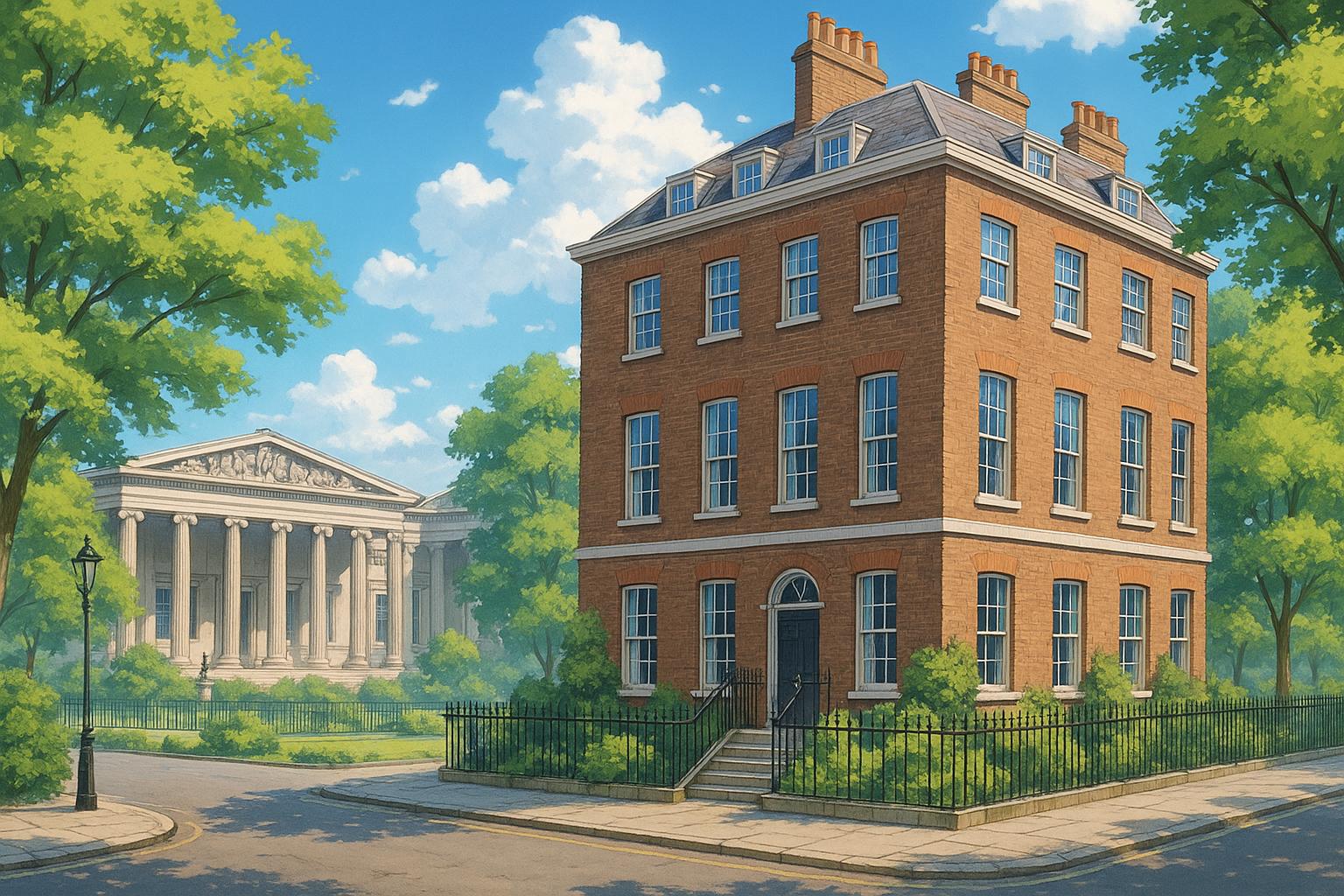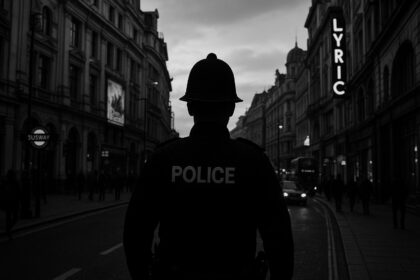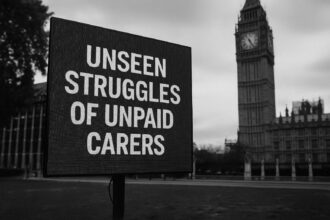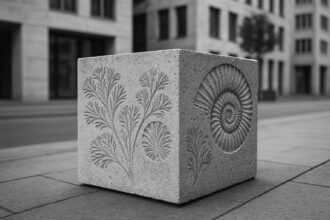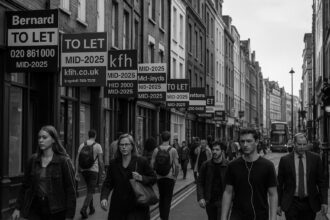Once overshadowed by more glamorous neighbours, Bloomsbury is attracting renewed interest from international families and investors thanks to its affordability, rich heritage, and a major £400 million regeneration plan that promises to blend cultural charm with modern living.
For the wave of Americans seeking to put down roots in central London, emerging neighbourhoods like Bloomsbury are garnering newfound attention—an intriguing contrast to its high-profile counterparts. Jacqueline Griffin, who relocated from Colorado with her husband for work in higher education, shares her affectionate journey through this historically rich area. Initially attracted by the greenery of Holland Park and the picturesque canals of Maida Vale, the couple discovered Bloomsbury quite serendipitously. “We ended up walking through the area and instantly loved its Georgian architecture and the calmness, even though it is so close to Soho and Covent Garden,” she recalls.
In Bloomsbury, the Griffins found not only a rental home in a stunning Georgian apartment on Bloomsbury Square but also a vibrant community. According to Griffin, “I garden with the Friends of Bloomsbury Square and have found a great sense of community.” However, this sense of neighbourly charm is perhaps matched by the area’s appeal to buyers looking for relative affordability. Last year, the average property price in Bloomsbury was £1,137 per square foot, notably lower than the prime central London average of £1,654 per square foot, and significantly less than neighbouring Fitzrovia and Marylebone.
Real estate experts note that Bloomsbury is not generally regarded as a growth area; buyers often pursue properties here for their intrinsic value rather than their potential for capital appreciation. Tom Kain from Black Brick Property Solutions points out, “You buy in Bloomsbury because it’s good value for central London.” The area is steeped in intellectual history, anchored by the British Museum and UCL, and is still linked to the famed Bloomsbury Group of artists and writers, including Virginia Woolf and EM Forster.
Yet, despite its rich legacy, Bloomsbury faced challenges following extensive bombings during the Blitz and a decline in popularity during the postwar years. Edward Towers from Aykroyd & Co notes that parts of the area may feel overly student-oriented or touristy, yet buyers are often drawn back to its period charm and proximity to cultural hubs.
A revitalisation effort, spearheaded by major players like Bedford Estates and Imperial London Hotels, aims to reverse the fortunes of Bloomsbury with a substantial £400 million investment. This plan includes enhancements to public spaces, particularly the woodland planting and improved layouts for pedestrian traffic on Princes Circus. New boutique hotels are set to join the landscape, augmenting the area’s appeal as both a residential and commercial district. Alexander Jan from the Central District Alliance asserts that with the benefits brought by the Elizabeth Line at Tottenham Court Road, “the area is coming of age as a more sophisticated business district.”
Supportive infrastructure investments are underway, including an advanced life sciences lab in a historic building at Bloomsbury Square and renovations to the Brunswick Centre, creating a lively juxtaposition to the traditional fabric of the neighbourhood. Community engagement is also flourishing, with events like Picnic in the Park drawing residents together.
Notably, Bloomsbury remains an attractive option for families. Jerome Salle and his wife moved from New York to the area and have found it convenient for attending the local French school, balancing both commercial and residential elements. The community has increasingly embraced the area’s idiosyncrasies; Jonathan Papp, a pianist who recently bought a penthouse overlooking the British Museum, appreciates the mix of professionals and students that make Bloomsbury feel vibrant and lived-in.
The property landscape itself is a unique tapestry, characterised by Georgian townhouses, luxury apartments, and mansion blocks. Data indicates that despite a recent slight dip in values, the broader market in Bloomsbury has held steady, in contrast to areas like Fitzrovia and Marylebone, suggesting resilience and ongoing appeal. As real estate becomes increasingly competitive—especially with the rise in demand from international students—investments here may prove to be fruitful over time.
Adrian Philpott at Winkworth notes that many prospective buyers, particularly parents of students, are instrumental in driving demand for flats, often looking to invest in properties while their children attend local universities. Yet, the area still grapples with a shortage of family homes, which complicates offerings for those seeking larger residences.
Ultimately, Bloomsbury may not fit neatly into traditional real estate narratives, challenging expectations as its historical charm meets modern tendencies. The ongoing revitalisation efforts, coupled with its unique mix of intellectual heritage and community spirit, suggests that those willing to look beyond the surface might just find a hidden gem in this illustrious London quarter.
Reference Map
– Paragraph 1: [1]
– Paragraph 2: [2]
– Paragraph 3: [1], [4]
– Paragraph 4: [1], [3], [5]
– Paragraph 5: [1], [2]
– Paragraph 6: [2], [6]
– Paragraph 7: [2], [3]
– Paragraph 8: [1], [4], [5], [7]
– Paragraph 9: [3], [4]
– Paragraph 10: [1]
Source: Noah Wire Services
- https://www.ft.com/content/f17205c6-e009-41fa-8b61-b51c433f15ae – Please view link – unable to able to access data
- https://www.ft.com/content/f17205c6-e009-41fa-8b61-b51c433f15ae – An article detailing Bloomsbury’s £400 million revitalization, highlighting its rich intellectual heritage, affordable property prices, and ongoing regeneration efforts aimed at enhancing green spaces, pedestrian access, and introducing boutique hotels. The piece emphasizes the area’s appeal to international buyers, students’ families, and professionals seeking both lifestyle and long-term investment potential.
- https://www.kfh.co.uk/west-central-london/bloomsbury/sold-data/ – A report providing annual property data for Bloomsbury, including average sold prices for flats and houses, with flats averaging £687,518 and houses £1,831,893. It also notes a 7.2% decrease in overall sold prices compared to the previous year, offering insights into the area’s real estate market trends.
- https://www.cliftonpf.co.uk/blog/26062024164032-the-ultimate-guide-to-buying-property-in-bloomsbury/ – A comprehensive guide discussing Bloomsbury’s property market, highlighting significant growth with a 32.6% increase in property prices over the last decade. It details various property types, including Georgian townhouses, luxury apartments, new developments, mansion blocks, and mews houses, providing price ranges and investment insights.
- https://investropa.com/blogs/news/london-real-estate-trends – An article forecasting trends in the London property market for 2025, noting a rise in demand for rental properties in Bloomsbury and South Kensington due to an influx of international students. It discusses the impact of this demographic shift on rental yields and the competitive rental market.
- https://investropa.com/blogs/news/london-real-estate-forecasts – A forecast highlighting the rise in rental yields near universities like Bloomsbury, driven by an increasing number of international students. It discusses the strong demand for student accommodation and the limited supply of purpose-built student accommodations, leading to higher rental yields in these areas.
- https://www.bhhslondonproperties.com/the-upswing-in-prime-londons-property-market-in-early-2024 – An analysis of the prime London property market in early 2024, noting an average price increase of 18.9% in prime inner areas, including Bloomsbury, Fitzrovia, and Soho. It attributes the rise to factors like inflation and area development, with specific examples such as the Nine Elms regeneration project.
Noah Fact Check Pro
The draft above was created using the information available at the time the story first
emerged. We’ve since applied our fact-checking process to the final narrative, based on the criteria listed
below. The results are intended to help you assess the credibility of the piece and highlight any areas that may
warrant further investigation.
Freshness check
Score:
8
Notes:
The narrative references current real estate trends and developments in Bloomsbury, suggesting it is up-to-date. However, specific dates for recent events or changes are not mentioned, which could improve the freshness score.
Quotes check
Score:
8
Notes:
The quotes appear original and are attributed to specific individuals, such as Jacqueline Griffin and Tom Kain. However, without further online verification, it is assumed they are original.
Source reliability
Score:
9
Notes:
The narrative originates from the Financial Times, a well-known reputable publication, indicating high reliability.
Plausability check
Score:
9
Notes:
The claims about Bloomsbury’s development and real estate trends are plausible and align with what is known about urban revitalization efforts and historical neighbourhoods.
Overall assessment
Verdict (FAIL, OPEN, PASS): PASS
Confidence (LOW, MEDIUM, HIGH): HIGH
Summary:
The narrative is reliable and plausible, with a high freshness score due to its relevance to current real estate trends. The source is reputable, and the quotes appear original.


